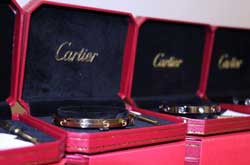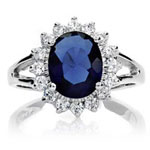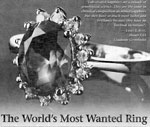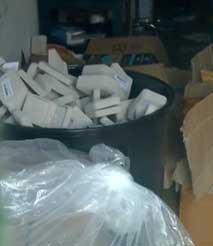Brand-name fakes: a tale of jewelry, duplicity, and international intrigue
Every so often we run a story about fake brand-name jewelry, aiming to remind insurers to look out for counterfeits masquerading as expensive brands.
In this issue we'll tell a single tale in some depth, because it illustrates the big picture, the variety of players and the tentacles of financial interests involved in the scheme that brings a counterfeit bracelet to a consumer's wrist.
The cache
In August of 2019, JianGang "Frank" Lan was arrested in Chapel Hill, North Carolina, for selling fake Cartier jewelry.
Authorities found 3,200 counterfeit bracelets, worth $24 million if they had been sold as genuine Cartier jewelry. North Carolina's secretary of state was astonished at the size of the cache. "Last year, as a state total, we took in $14 million," she said. "This greatly exceeded it in one bust."
Trademark enforcement agents had found the knockoff bracelets in Deer Park Community Church, where Lan was pastor. The day before Lan was arrested, he had asked a man who works at the Interfaith Shelter next door to the church if he could use the shelter's dumpster to dispose of some boxes. After Lan's arrest, the man wondered whether those boxes had been filled with counterfeit jewelry. By that time the church was closed and its identifying signage had been papered over.
Lan's bond was set at $25,000, higher than the usual, because he had told law enforcement officers of his plans to leave the state on the coming weekend. When he failed to appear for his court date in September, his bail was raised to $1 million.
Connections
Eventually authorities learned that Lan had gone to China.
China is by far the world's largest exporter of "imitation" jewelry—which includes fake brand-name jewelry, as well as jewelry made with low-quality gems, imitation gems, fraudulently marked or unmarked metals, etc. China even produced replicas of the ring Prince William gave his fiancée Kate Middleton and sold tens of thousands of the knockoffs around the world.
Of the many shipments of counterfeit jewelry that customs officials intercept, most are from China. It is a manufacturing hub with experienced and low-paid laborers, and China's cost for shipping to other countries is very low.
"In general in counterfeit cases," noted a North Carolina official, "we understand that counterfeiting can lead to other kinds of crimes like money laundering or human trafficking. We've found that before."
Newsweek subsequently reported that Lan was suspected of participating in a "trade-based money laundering" scheme connected to a crime syndicate in China.
Newsweek's reporting also drew ties between Lam and David Jang. Jang founded Olivet University, where Lam had been a student, and World Olivet Assembly. Olivet was investigated for fraud and money laundering in 2018, resulting in guilty pleas by Jang and several of his associates. Jang was fined $1.25 million.
More recent investigations focused on possible visa fraud and human and labor trafficking, as well as more money laundering. Federal and local agencies were looking into whether the World Olivet Assembly sponsored U.S. visas for foreign students, mostly from China, who then spent most of their time in the U.S. working rather than studying, and who were paid well below minimum wage.
Law enforcement also suspected links to drug cartels, which look to China to buy the precursor chemicals needed to make fentanyl, the powerful opioid behind a surge of deadly drug overdoses in the U.S.
When it comes to money laundering and Chinese nationals, "there is almost always a nexus between Chinese organized crime and drug cartels," said a former employee of the Drug Enforcement Agency.
Chinese organized crime often uses complex trade-based schemes to get their drug proceeds out of the U.S., and fake brand-name jewelry could be one of those schemes.
So: counterfeit jewelry, trademark infringement, smuggling, money laundering, drug cartels, opioid production, illegal international trade, visa fraud, and possibly labor trafficking all come into the mix. And the man arrested for housing the counterfeit jewelry stash is currently abroad and out of the reach of U.S. law.
But back to jewelry
Counterfeit brand-name jewelry is a whole market in itself. Besides manufacturing and transporting the jewelry itself, there is the paraphernalia that serves to substantiate the jewelry's bogus brand—such as gift boxes that mimic the genuine ones; bogus appraisals, lab reports, and warrantee papers; websites that advertise the jewelry; locations like Lan's church in North Carolina to warehouse it, etc. It's a thriving business, with everyone along the way getting their cut. And this is only one instance of many similar operations.
In the North Carolina bust some 3,200 fake Cartier bracelets were discovered, but how many were there originally? How many had already found their way into the marketplace? Authorities believe they were destined for Craigslist and online auction sites. Maybe some are already on consumers' wrists.
Maybe you've even insured them.
FOR AGENTS & UNDERWRITERS
 Counterfeit brand-name merchandise is a flourishing business, especially on the Internet. Be careful with all jewelry purchased online.
Counterfeit brand-name merchandise is a flourishing business, especially on the Internet. Be careful with all jewelry purchased online.
A consumer may have purchased a fake at a low price and now want it insured as the genuine article. Though the consumer was fooled, the insurer should not be. Check the docs!
The sales receipt is an import document. It can verify the seller and the brands carried.
The sales receipt can also help you spot inflated valuations. If there's a huge difference between appraised value and purchase price, the purchase price is most likely a more accurate indicator of value.
High-value jewelry should have a descriptive appraisal and a lab report.
High-value name brand jewelry should come from an authorized dealer in that brand. The jewelry should have a certificate of authenticity, and the sales receipt will carry the name of the authorized dealer.
If the policyholder does not have such documents, they should have the piece authenticated by an authorized dealer. In the event of a claim, you don't want to replace a cheap fake with the genuine article!
Many customers may not be aware that luxury jewelry bought from sources other than an authorized dealer may be counterfeit, despite any logos, quality markings or trademarks. Insisting on complete information about the piece not only protects the insurer but is a service to the policyholder.
The best appraisal includes the JISO 78/79 appraisal form and is written by a qualified gemologist (GG, FGA+, or equivalent), preferably one who has additional insurance appraisal training. One course offering such additional training is the Certified Insurance Appraiser™ (CIA) course of the Jewelry Insurance Appraisal Institute.
FOR ADJUSTERS
Be wary of fraud. The insured may know the jewelry is fake and try to cash in through an insurance claim. Use every means possible to be sure a high-value item is genuine.
On a damage claim, ALWAYS have the jewelry examined in a gem lab that has reasonable equipment for the job and is operated by a trained gemologist (GG, FGA+ or equivalent), preferably one who has additional insurance appraisal training, such as a Certified Insurance Appraiser™.
For gemstone jewelry, inspect the appraisal and diamond report carefully for terms suggesting that the stone has been enhanced or treated. More specific terms to look for include coated, irradiated, HPHT, and CVD.
©2000-2025, JCRS Inland Marine Solutions, Inc. All Rights Reserved. www.jcrs.com






